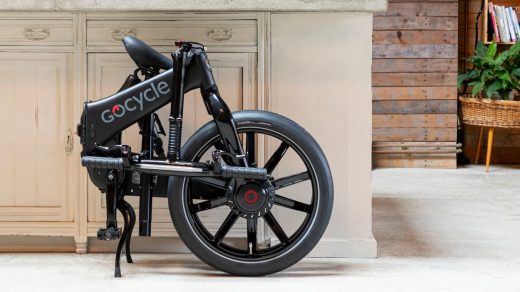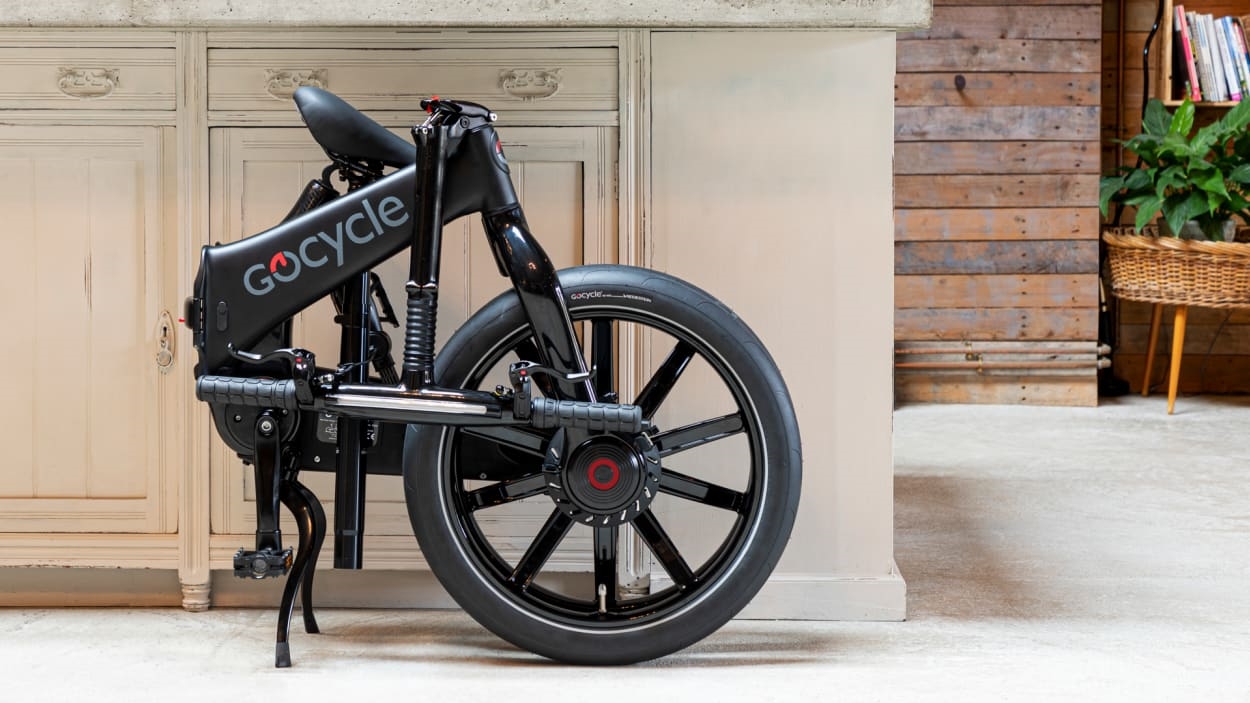This radical folding e-bike could change how you live in the city
I love to ride bikes. And I’ve spent a meaningful percentage of my life working in big cities. But I’ve only rarely gotten around urban environments on two wheels. Maybe that’s because bicycles, when you’re not on them, can be a burden. They’re big and bulky, are difficult to meld with other means of transit (such as subways), and aren’t always welcome in offices. They’re also at risk of being stolen if you leave them outside, regardless of how well you’ve locked them up.
There is, however, one basic design element a bike maker can implement to address all these downsides. Bikes can be made foldable, so they take up less space and are more portable. And if you combine foldability with all the virtues of e-bikes—which use a motor to let you go faster and further, even when daunting hills are involved—you get a transportation device with the potential to be transformative. So when I had the opportunity to try a Gocycle, from British e-bike maker Karbon Kinetics, I wanted to put it through its paces in downtown San Francisco—as well as suburbia, where I live these days.
The GoCycle G4i that I tested isn’t the perfect e-bike for everybody, and even if it were, its $5,999 price tag would be an obstacle for most of us. (The slightly less fancy Gocycle G4 goes for $3,999, and other e-bike manufacturers offer models for a lot less than that.) But its unique, ambitious design makes for a bike that’s practical in ways no non-folding model is, without sacrificing anything that’s great about e-bikes in their more conventional form.
Like their non-electrified ancestors, many e-bikes heavily depend on stock components provided by a few big suppliers, leaving models from different companies feeling strikingly similar. Gocycle’s e-bikes are different. Created by a former designer at race-car maker McLaren, the G4i is as bespoke a bike as I’ve ever been on. It does away with familiar elements such as conventional spoked wheels and chained gears and has a carbon-fiber frame unlike anything I’ve ever seen. Even the tread on the tires, which the company says drew inspiration from grippy Grand Prix motorcycle tires, isn’t standard stuff.
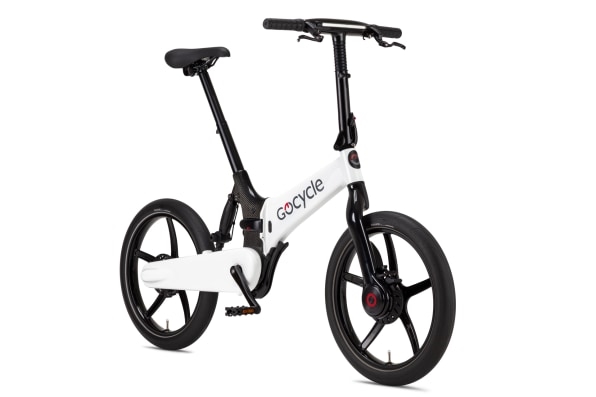
After building multiple generations of e-bikes, the Gocycle’s maker has nailed the foldability aspect. There’s a hinge near the G4i’s middle, another at the base of the handlebars, and a bungee-like elastic that keeps the bike from swinging open when it’s folded. The company claims that you can fold the bike in 10 seconds, and while I never quite hit that pace, the steps involved are remarkably obvious. Once I got the knack, it almost felt like the bike folded and unfolded itself.
E-bikes tend to be heavy—Rad Power Bikes’ RadRunner Plus weighs in at 77 pounds—which is only a major problem if you have to pick one up. But the Gocycle is officially just 37.7 pounds (not including its kickstand), which is light enough that I could lift it without sweating it, such as when I took it inside buildings. You can also roll the folded bike, using its seat as a handle.
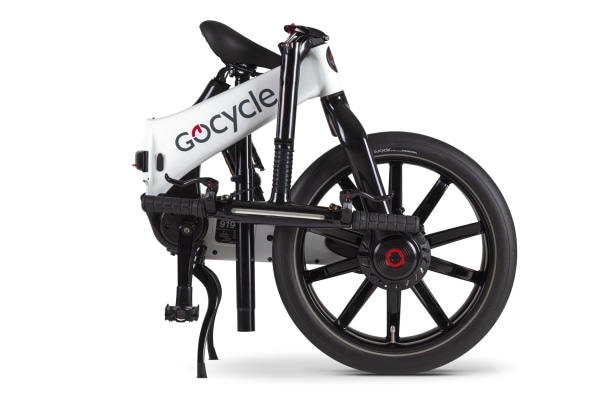
Ultimately, though, what the bike is like when it’s folded matters less than what it’s like when you’re on it—and here, the Gocycle G4i excels. It doesn’t ride exactly like a conventional e-bike, probably because the wheels are only 20 inches. But in many ways, that’s a virtue: The bike was easy for me to mount and dismount, felt surprisingly nimble, and offered both front-wheel and seat suspension to cushion you against bumps in the road. Most important, it was as stable as a typical bike, without any of the wobbliness you might expect the hinges to introduce.
In general, the Gocycle’s design aims to reduce the complexities that can make owning a bike a headache. For instance, it uses an enclosed three-speed transmission from Shimano—one of the few outsourced components—that shifts smoothly and doesn’t require a messy exposed chain. With its sealed-up design, this bike doesn’t just look more like a streamlined appliance than garden-variety bikes designed to please hardcore cyclists do; it works more like one, too.
On the road (and in the subway)
As I worked the Gocycle into my daily routine, I kept discovering its benefits. On the San Francisco Bay Area’s BART subway, there are rules about which cars you can take your bicycle into at which hours—except for folding bikes, which are welcome everywhere at any time. The San Francisco WeWork where I work has no provisions for bike storage, so after taking BART into town from my home outside the city, I just toted the folded Gocycle into an elevator and took it up to my office. The security guys either didn’t notice or didn’t care.
Normally, I’d also be skittish about leaving a $6,000 e-bike in notoriously bike-theft-prone downtown San Francisco, where even a hefty lock isn’t much of a defense. But when I attended an event at a second-floor space in a restaurant, I got there via the Gocycle, brought it inside, easily whisked it up the stairs, and tucked it into a corner, where it doubled as a rack for my coat. That kind of freedom could change how you live in an urban environment.
For some urbanites, the Gocycle might even replace a car—since you’re much less likely to get bogged down in traffic and won’t need to hunt for a parking space. It’s not optimized to render automobiles obsolete, though: There’s no way to take along a passenger, and it’s not a cargo bike. I stuck anything I needed to carry, such as my laptop, in a backpack. But you can expand its capacity with an optional rack and/or front-mounted pannier bag.
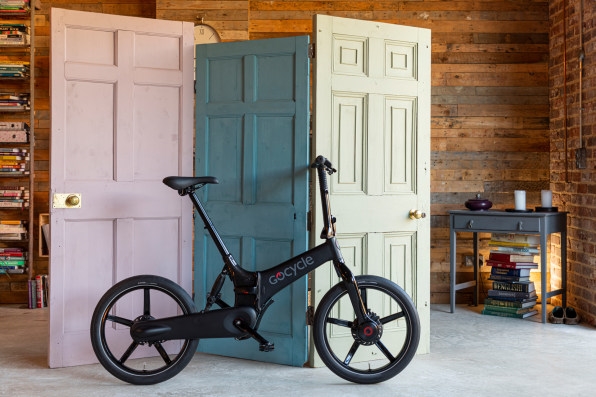
Speaking of cars, the folded Gocycle also slipped neatly into the hatch of my Ford Focus, once I’d folded down the seats. I can cram my Gazelle e-bike in there, too, but that requires removing the front wheel. And even then, the Gazelle is a tight enough squeeze that I once damaged the front fender, necessitating its replacement. I’d be a lot more inclined to take the Gocycle along. And I did when I made a car trip to San Rafael, a lovely area for biking.
Okay, now for the things about the Gocycle G4i I didn’t love. It handled most of the hills I threw at it with aplomb. But on one particularly long climb near my home—which taxes every e-bike I’ve tried except my own Gazelle—it was tough to make it all the way up without relying on the throttle, which lets you zoom along with little or no pedaling. That’s when I learned that the bike sometimes abruptly cuts off the extra power to preserve juice when the battery is low, leaving me in danger of falling off.
Then there’s the fact that the G4i’s 375-watt-hour battery is a bit on the small side. Gocycle says it can provide up to 50 miles of biking on a charge, but I didn’t get anywhere near that, probably because using the throttle was so much fun. I decided not to risk a 40-mile loop through San Francisco and over the Golden Gate Bridge, an adventure I’ve undertaken on several other e-bikes.
I’m also not sure what Karbon Kinetics was trying to accomplish with the Gocycle’s display, which isn’t really a display at all. Instead, it’s a bunch of colored LEDs splayed between the handlebar grips that indicate information, such as the gear you’re in and the remaining battery charge, by lighting up or flashing. (Even after I checked the documentation, I didn’t always understand what the bike was trying to tell me.) You can mount your smartphone to the handlebars—they have elastics for that purpose—and use the Gocycle app, which has more conventional gauges. But you might not want to go that route, say, if you’re routing your trip in Google Maps.
After spending some time aboard this e-bike, I realized that it’s possible to ride it without obsessing over the controls as long as you don’t accidentally drain the battery. That was a lesson in itself. The Gocycle G4i doesn’t ask much of the rider except for periodic charging. And even though it could use a more straightforward display, the G4i feels incredibly simple, despite the complex engineering that makes it all possible. Whether you’re talking about a bicycle or a smartphone, that’s a bar that few pieces of personal technology meet.
(21)

